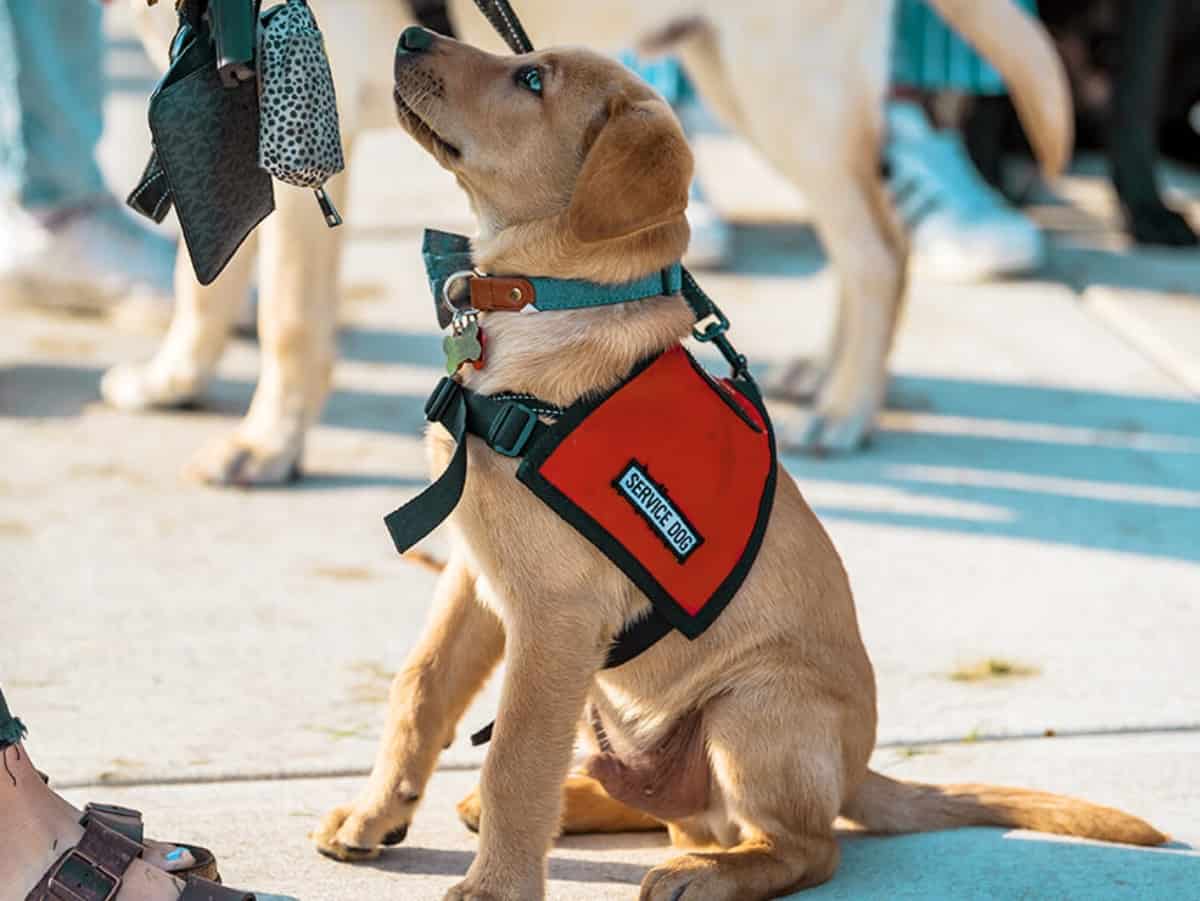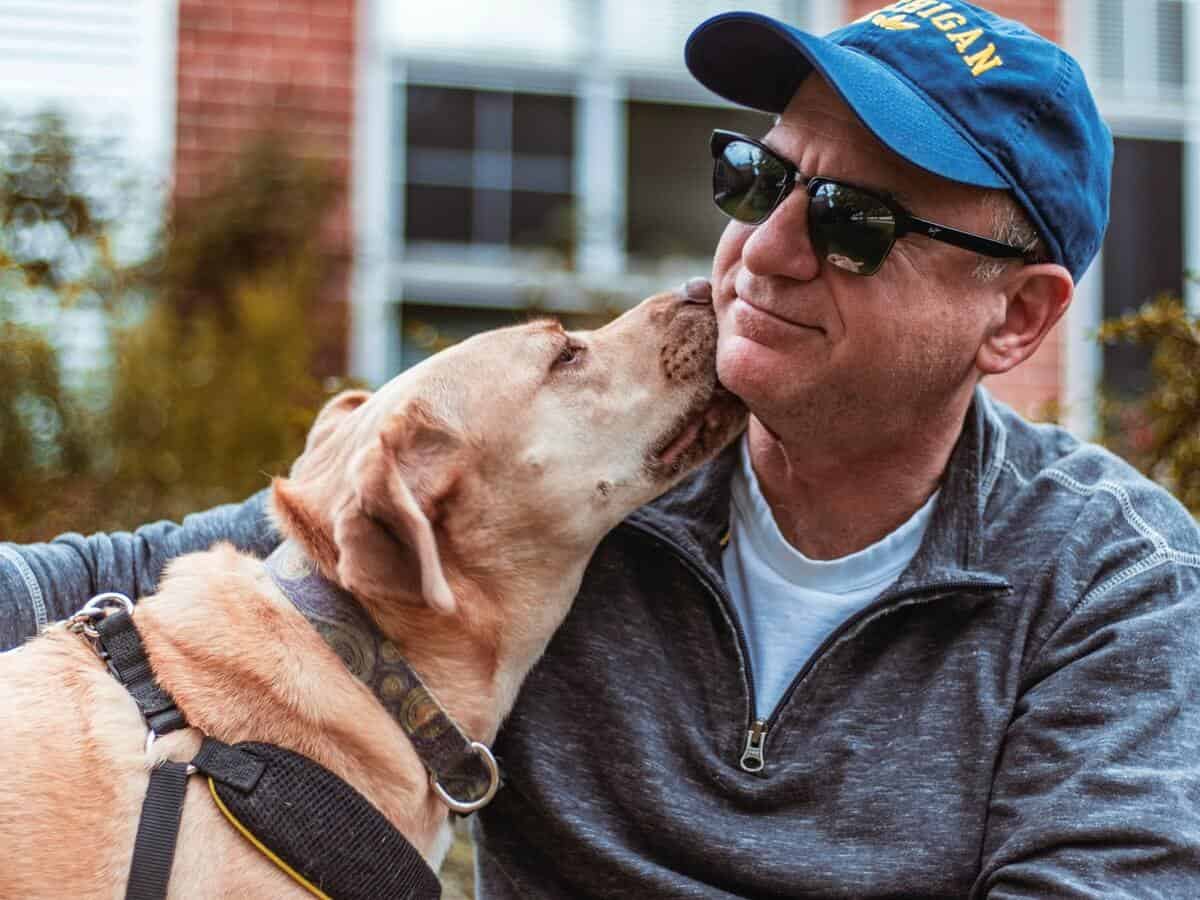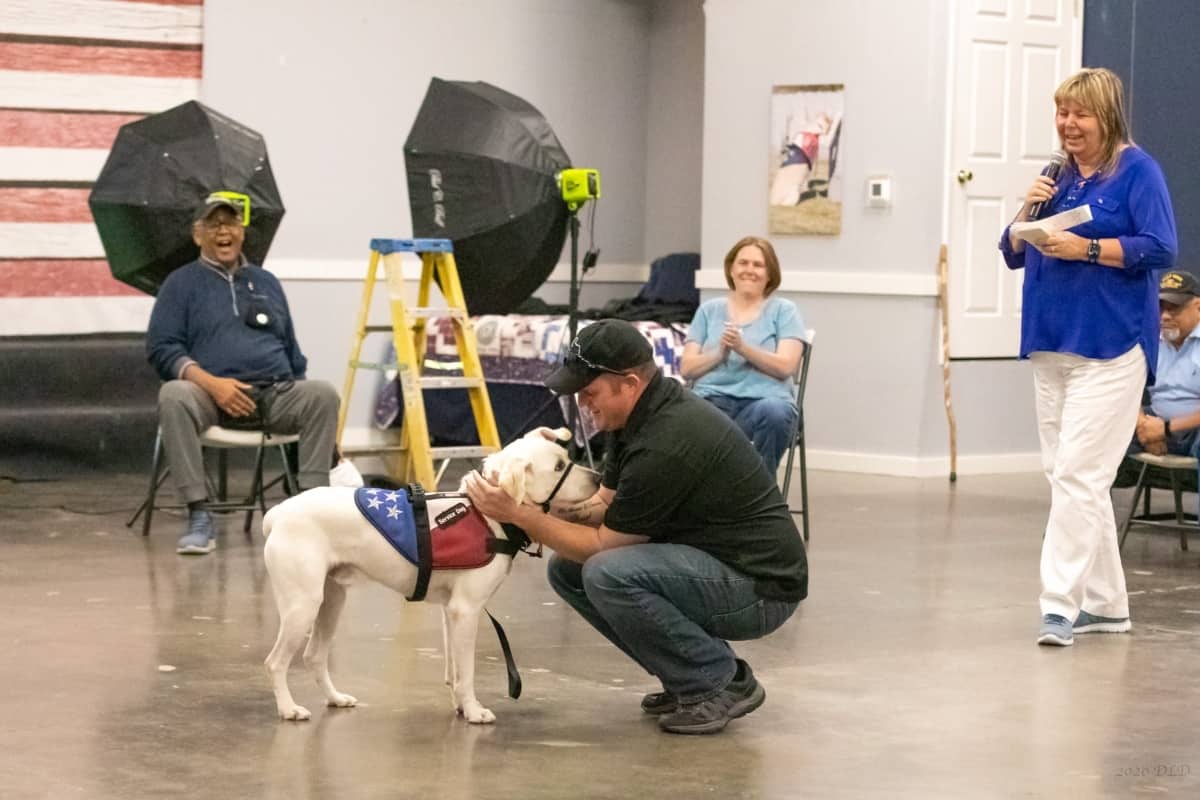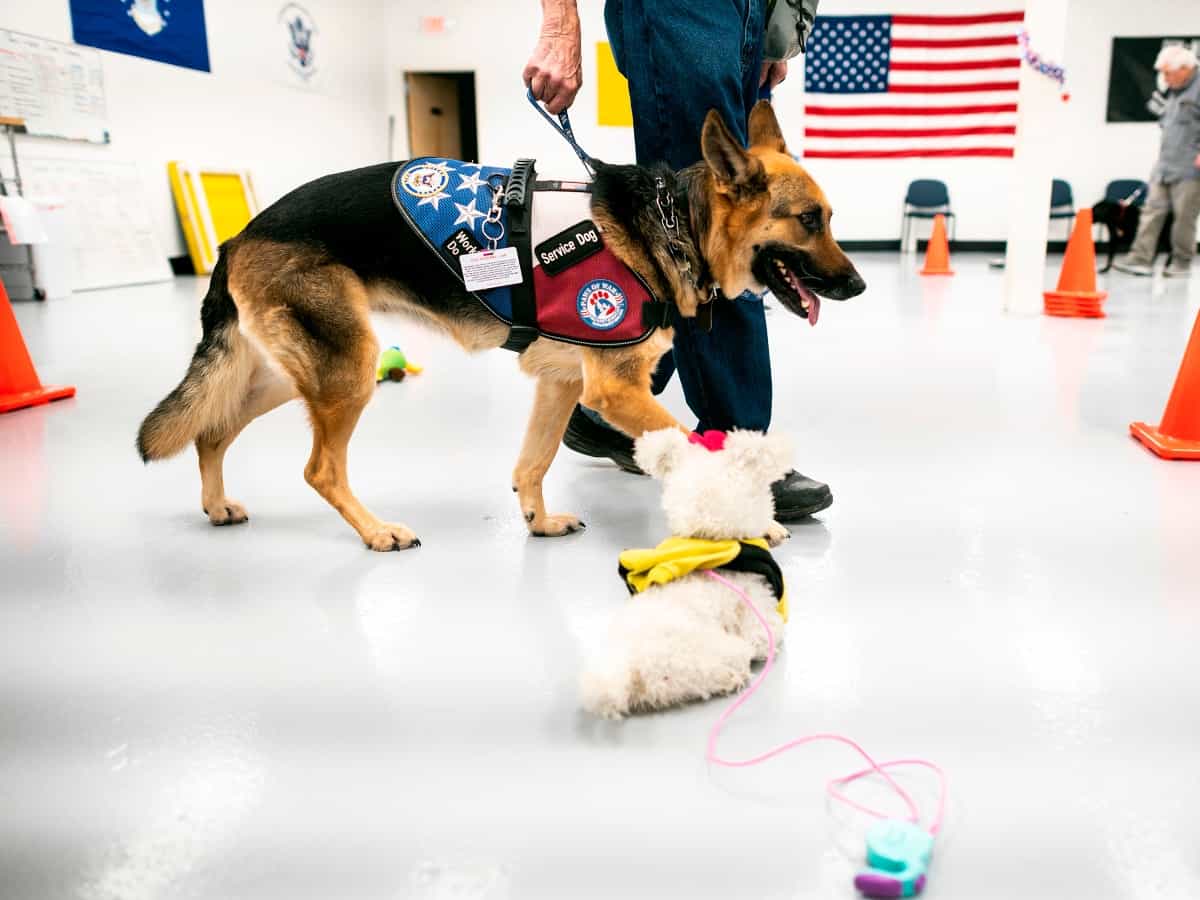Service dog etiquette is a really important topic; however, it is rarely discussed. It’s likely that you have been in public and seen a service dog and didn’t know the proper service dog etiquette. But did you know that there are rules to approaching a service dog? You should avoid doing certain things around service dogs, for not only your safety, but theirs too!
Marissa Pittman, Development Coordinator for Patriot PAWS says, “Something important to remember is that Service Dogs are working. Even if you may not be able to see it, they are working hard to make sure they are assisting in mitigating their handler’s disability(ies) / injury(ies) – again, important to remember that not all injuries and disabilities are visible. Whether it be retrieving items or providing comfort in stressful situations, Service Dogs are always working, especially when in public.”
#1. Speak to the Owner First, Before Approaching the Assistance Dog
The golden rule of service dog etiquette is to ask a service dog’s handler if you can meet their service dog. Service dogs are constantly on the job while in public. They must protect their owner from harm’s way. You are instantly a stranger in a dog’s eyes, even if you look friendly. Service dogs are trained to assist and deal with one person, so they may not be ready or prepared to interact with you. Also, remember not to call out to the service dog directly because that also distracts it. If you know its owner, call out to the owner first.
“By coming up and immediately attempting to interact with the dog, it’s important to be mindful that you could be distracting them from their handler. Please always ask the handler if it is okay to pet or interact with their Service Dog, and be understanding if they say no. We always want to do our best in explaining that a Service Dog is a tool to assist with an injury / disability to the same extent that a wheelchair or cane is used as a tool,” says Pittman.
While service dogs need a calm temperament in public to get certified, you should keep in mind the owner’s feelings. People live all sorts of lives. An owner can have a bad day, just like how you can have a bad day! Service dogs are typically trained from birth at special schools. The bulk of their training is in-person doing mock tasks. So, they should be used to dealing with strangers and interacting with them accordingly. Service dog etiquette is a two-way street.

#2. Don’t Interact with a Service Dog if it Approaches You
Continuing from the golden rule, if a service dog approaches you, it does not want you to pet it. Service dogs sniff you to get an idea of their surroundings to help their owner. You must avoid touching them despite all of your instincts. If you ask or the handler gives the okay, you can pet a service dog. If you have permission to touch a service dog, consider limiting how long you interact with it. Service dogs can get distracted if you pet them for too long. Also, never issue them commands, especially if you do not know them.
#3. Never Pet a Service Dog’s Head
If you are allowed to pet a service dog, consider the following. Always approach the dog gently and calmly. Avoid touching their head because it distracts them from their job. By approaching a service dog, you divert their attention from potential danger. Standing in front of a service dog obstructs its field of vision and makes it have a difficult time smelling. The best place to touch a service dog is on the shoulders. Even if a vest is obstructing their shoulders, that is the best place to pet. You can also put it on its back.
#4. Employees are Allowed to Ask Service Dog Owners Two Things About Their Dogs
If a disabled owner walks into a store, an employee or manager can ask them two things. What disability do you have that you need a service dog for? And “What are its tasks? Handlers can show their dog’s registration if they don’t want to be bothered. Depending on your state, a service dog may not have to wear a vest or harness. It is essential to keep this in mind because these questions aren’t discrimination under the Americans with Disabilities Act (ADA). The ADA gives public protection for service dog handlers with disabilities.
#5. A Service Dog Doesn’t Always Have to Wear a Vest
The ADA does not require service dogs to wear vests or have identifying tags or cards on them. However, if you are a handler, it may save you some trouble in public. It is easy to tell when a handler is blind, and they likely will not be bothered unless they own a fake service dog. However, other owners may have disabilities that are harder to spot. If you want to circumvent this, purchase a vest or carry an ID card. Many US states have departments that issue service dog IDs. Check with your local government agencies to find out more information.

#6. Service Dog Handler Etiquette Tips
Service dogs aren’t the only ones you have to be considerate of. Try to be polite to handlers and do not say anything rude. They also shouldn’t be distracted, just like their service dogs.
Some don’ts for interacting with a handler:
Don’t:
- Mention or bring up their disability
- Try to touch the handler or their leash
- Be rude or inconsiderate of them or their disability
- Get too close to them
If talking to them, take extra care not to mention or ask about their disability. If you want to know about the dog’s tasks and training, let them bring it up naturally. Unless you are looking for a service dog for yourself, a family member, or a friend, it is uncouth to ask.
#7. Don’t Feed a Service Dog without Permission
This holds for anyone’s pet, but especially for service dogs. Service dogs have to keep up a consistent and healthy diet and eating routine to keep their senses sharp. It is of the utmost importance not for them to deviate from this. An unhealthy or sick service dog cannot fully assess or help its owner if danger happens. Sickness harms both the owner and the dog. It also isn’t considerate to the owner because the owner has to deal with the sick dog.
#8. Do Not Walk Too Close to a Service Dog
One of the best ways to avoid distracting a service dog is by keeping your distance from it. All dogs are naturally interested in what you are doing. So, please do your best to stay clear of a handler and their dog. Sometimes this is unavoidable, and handlers understand that you have to go about your business as well. Most people do not understand or know service dog etiquette. So, they are used to these situations. However, try to do your best and pay attention to how you act around a service dog. If you see someone else walking too close to a service dog or interacting incorrectly, it is okay to say something. Just don’t be rude, and try not to embarrass the handler.

#9. Do Not Assist a Service Dog Handler Immediately if a Service Dog is Unruly
If you are ever in a store or public location and a service dog is acting unusual, do not act immediately. Service dogs do all sorts of tasks for their owners. There are many types of service dogs, including guide dogs, seeing-eye dogs, alert dogs, etc. Some service dogs help blind owners avoid foods their allergic to by alerting them or tugging on their leash. Other alert dogs help deaf owners from running into objects. On the other hand, if you genuinely believe a service dog is not doing its job, you should proceed differently. Remember, you should always ask a handler before interacting with a service dog. A simple way of asking a handler to help is by letting them know the situation as you see it. You can also just ask, “do you need help?” Most handlers will let the people around them know if they need help. A common situation where you may need to help a handler is when a service dog goes off-leash.
#10. Service Dogs are Still Dogs
Whenever a service dog is off the clock, it still acts like an average dog. Service dogs need some time off, just like people do, to relax, play, get treats, and burn off some energy. Once they take off their vest or tags, they are just like other dogs. However, if this service dog isn’t your own, be careful not to break any of the handler’s rules. Still, let its owner dictate their diet and be hesitant when approaching a service dog. As long as a service dog is in public, it is not on break. Once a service dog gets home, it gets to relax. Don’t think that just because a service dog is lying down or sleeping, it is no longer helping its owner.
Dog Owner’s Homes are in Top Condition Thanks to ONIT Home
Once your service dog returns home, the roles are reversed. It is time for you to start taking care of them. While they will still help you out around the house, there are certain things a service dog cannot alert you to. ONIT Home’s smart security systems safeguard your home from all angles. Check-in from anywhere to see activity in your home to make sure your home is safe and secure!
Call us now at 1-833-433-0331 or visit us online to learn more!



